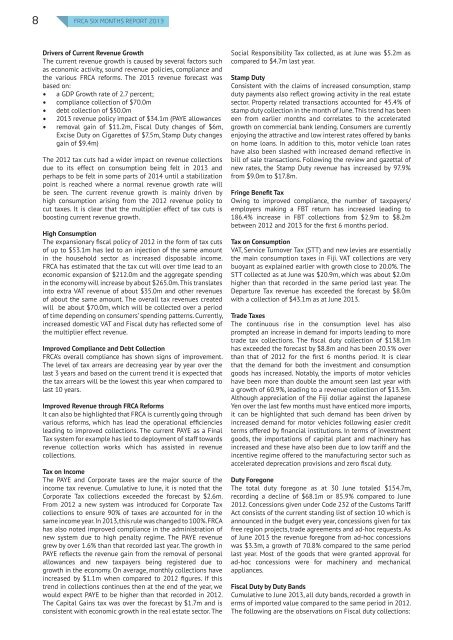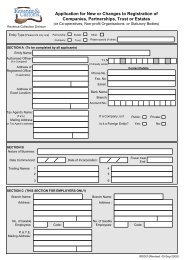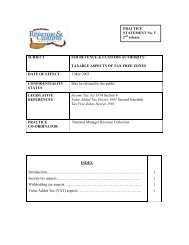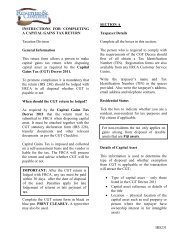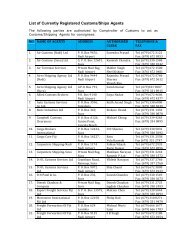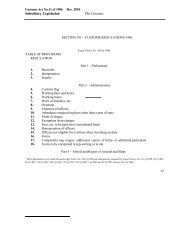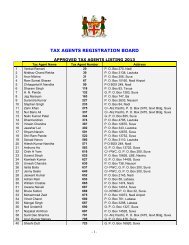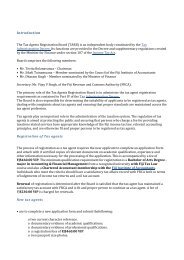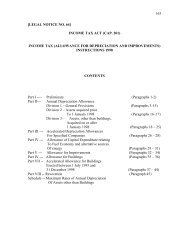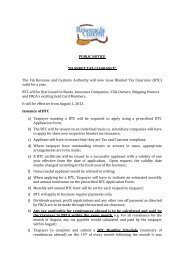REPORT 2013
Half Year Report 2013 - Fiji Revenue & Customs Authority
Half Year Report 2013 - Fiji Revenue & Customs Authority
- No tags were found...
Create successful ePaper yourself
Turn your PDF publications into a flip-book with our unique Google optimized e-Paper software.
8 FRCA SIX MONTHS <strong>REPORT</strong> <strong>2013</strong><br />
Drivers of Current Revenue Growth<br />
The current revenue growth is caused by several factors such<br />
as economic activity, sound revenue policies, compliance and<br />
the various FRCA reforms. The <strong>2013</strong> revenue forecast was<br />
based on:<br />
• a GDP Growth rate of 2.7 percent;<br />
• compliance collection of $70.0m<br />
• debt collection of $50.0m<br />
• <strong>2013</strong> revenue policy impact of $34.1m (PAYE allowances<br />
• removal gain of $11.2m, Fiscal Duty changes of $6m,<br />
Excise Duty on Cigarettes of $7.5m, Stamp Duty changes<br />
gain of $9.4m)<br />
The 2012 tax cuts had a wider impact on revenue collections<br />
due to its effect on consumption being felt in <strong>2013</strong> and<br />
perhaps to be felt in some parts of 2014 until a stabilization<br />
point is reached where a normal revenue growth rate will<br />
be seen. The current revenue growth is mainly driven by<br />
high consumption arising from the 2012 revenue policy to<br />
cut taxes. It is clear that the multiplier effect of tax cuts is<br />
boosting current revenue growth.<br />
High Consumption<br />
The expansionary fiscal policy of 2012 in the form of tax cuts<br />
of up to $53.1m has led to an injection of the same amount<br />
in the household sector as increased disposable income.<br />
FRCA has estimated that the tax cut will over time lead to an<br />
economic expansion of $212.0m and the aggregate spending<br />
in the economy will increase by about $265.0m. This translates<br />
into extra VAT revenue of about $35.0m and other revenues<br />
of about the same amount. The overall tax revenues created<br />
will be about $70.0m, which will be collected over a period<br />
of time depending on consumers’ spending patterns. Currently,<br />
increased domestic VAT and Fiscal duty has reflected some of<br />
the multiplier effect revenue.<br />
Improved Compliance and Debt Collection<br />
FRCA’s overall compliance has shown signs of improvement.<br />
The level of tax arrears are decreasing year by year over the<br />
last 3 years and based on the current trend it is expected that<br />
the tax arrears will be the lowest this year when compared to<br />
last 10 years.<br />
Improved Revenue through FRCA Reforms<br />
It can also be highlighted that FRCA is currently going through<br />
various reforms, which has lead the operational efficiencies<br />
leading to improved collections. The current PAYE as a Final<br />
Tax system for example has led to deployment of staff towards<br />
revenue collection works which has assisted in revenue<br />
collections.<br />
Tax on Income<br />
The PAYE and Corporate taxes are the major source of the<br />
income tax revenue. Cumulative to June, it is noted that the<br />
Corporate Tax collections exceeded the forecast by $2.6m.<br />
From 2012 a new system was introduced for Corporate Tax<br />
collections to ensure 90% of taxes are accounted for in the<br />
same income year. In <strong>2013</strong>, this rule was changed to 100%. FRCA<br />
has also noted improved compliance in the administration of<br />
new system due to high penalty regime. The PAYE revenue<br />
grew by over 1.6% than that recorded last year. The growth in<br />
PAYE reflects the revenue gain from the removal of personal<br />
allowances and new taxpayers being registered due to<br />
growth in the economy. On average, monthly collections have<br />
increased by $1.1m when compared to 2012 figures. If this<br />
trend in collections continues then at the end of the year, we<br />
would expect PAYE to be higher than that recorded in 2012.<br />
The Capital Gains tax was over the forecast by $1.7m and is<br />
consistent with economic growth in the real estate sector. The<br />
Social Responsibility Tax collected, as at June was $5.2m as<br />
compared to $4.7m last year.<br />
Stamp Duty<br />
Consistent with the claims of increased consumption, stamp<br />
duty payments also reflect growing activity in the real estate<br />
sector. Property related transactions accounted for 45.4% of<br />
stamp duty collection in the month of June. This trend has been<br />
een from earlier months and correlates to the accelerated<br />
growth on commercial bank lending. Consumers are currently<br />
enjoying the attractive and low interest rates offered by banks<br />
on home loans. In addition to this, motor vehicle loan rates<br />
have also been slashed with increased demand reflective in<br />
bill of sale transactions. Following the review and gazettal of<br />
new rates, the Stamp Duty revenue has increased by 97.9%<br />
from $9.0m to $17.8m.<br />
Fringe Benefit Tax<br />
Owing to improved compliance, the number of taxpayers/<br />
employers making a FBT return has increased leading to<br />
186.4% increase in FBT collections from $2.9m to $8.2m<br />
between 2012 and <strong>2013</strong> for the first 6 months period.<br />
Tax on Consumption<br />
VAT, Service Turnover Tax (STT) and new levies are essentially<br />
the main consumption taxes in Fiji. VAT collections are very<br />
buoyant as explained earlier with growth close to 20.0%. The<br />
STT collected as at June was $20.9m, which was about $2.0m<br />
higher than that recorded in the same period last year. The<br />
Departure Tax revenue has exceeded the forecast by $8.0m<br />
with a collection of $43.1m as at June <strong>2013</strong>.<br />
Trade Taxes<br />
The continuous rise in the consumption level has also<br />
prompted an increase in demand for imports leading to more<br />
trade tax collections. The fiscal duty collection of $138.1m<br />
has exceeded the forecast by $8.8m and has been 20.5% over<br />
than that of 2012 for the first 6 months period. It is clear<br />
that the demand for both the investment and consumption<br />
goods has increased. Notably, the imports of motor vehicles<br />
have been more than double the amount seen last year with<br />
a growth of 60.9%, leading to a revenue collection of $13.3m.<br />
Although appreciation of the Fiji dollar against the Japanese<br />
Yen over the last few months must have enticed more imports,<br />
it can be highlighted that such demand has been driven by<br />
increased demand for motor vehicles following easier credit<br />
terms offered by financial institutions. In terms of investment<br />
goods, the importations of capital plant and machinery has<br />
increased and these have also been due to low tariff and the<br />
incentive regime offered to the manufacturing sector such as<br />
accelerated deprecation provisions and zero fiscal duty.<br />
Duty Foregone<br />
The total duty foregone as at 30 June totaled $154.7m,<br />
recording a decline of $68.1m or 85.9% compared to June<br />
2012. Concessions given under Code 232 of the Customs Tariff<br />
Act consists of the current standing list of section 10 which is<br />
announced in the budget every year, concessions given for tax<br />
free region projects, trade agreements and ad-hoc requests. As<br />
of June <strong>2013</strong> the revenue foregone from ad-hoc concessions<br />
was $3.3m, a growth of 70.8% compared to the same period<br />
last year. Most of the goods that were granted approval for<br />
ad-hoc concessions were for machinery and mechanical<br />
appliances.<br />
Fiscal Duty by Duty Bands<br />
Cumulative to June <strong>2013</strong>, all duty bands, recorded a growth in<br />
erms of imported value compared to the same period in 2012.<br />
The following are the observations on Fiscal duty collections:


